Canon EOS 30D review
-
-
Written by Gordon Laing
Canon EOS 30D design and build quality
At first glance the Canon EOS 30D looks almost indistinguishable from the earlier 20D, but place them side by side and subtle differences emerge. The 30D’s grip is fractionally larger, while certain surfaces and joins are more rounded, lending it a slightly chunkier appearance. The surface connecting the left side of the body with the lens mount is more angled-out for example, resembling the 5D. The most obvious physical difference between the 20D and 30D though is the latter’s larger 2.5in screen – a much needed increase from the 20D’s 1.8in model, but more on that later. The 30D is pictured below, alongside the 5D.
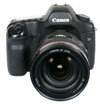

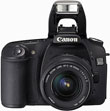 |
In terms of build quality, the 30D feels pretty much the same as the 20D and 5D bodies. It’s solid and comfortable to hold, with key surfaces coated with a mottled rubber finish for durability and grip. If you’re coming from the 300 or 350D / Digital Rebel line, it’s a significant step-up in build quality, although as we mentioned in our 5D review, the Nikon D200 ultimately feels tougher – although to be fair it’s also priced higher than the 30D.
Like its predecessor, the 30D’s equipped with a popup flash above its Pentaprism head, with coverage to 17mm (27mm equivalent). Some photographers consider popup flashes on SLRs to be a waste of time, but we personally find them very handy, especially as fill-ins on dull days. Indeed a popup flash is one of the things we miss the most on the 5D. If you’re after more serious illumination, the 30D also sports a PC Sync port and hotshoe for EX series Speedlites.
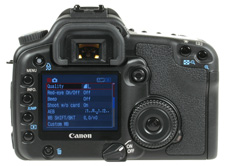 |
If you’re familiar with the 20D or the 5D, you’ll feel immediately at home with the control layout of the 30D which is dominated by the same thumb-operated command wheel on the rear. This navigates menus and cycles through various settings and is tactile, intuitive and fast to use.
The wheel itself can be disabled or enabled depending on the position of the three-way power switch to its lower left, although most will leave it active. In this position it can be used to adjust exposure compensation in all but Manual mode, where it instead controls the aperture.
Again like the 20D and 5D, most of the key controls are located on the top surface. The main command dial offers the usual Auto (green square), Program, Manual, Shutter and Aperture Priority modes, along with five scene presets, an auto depth-of-field option and a setting which disables the flash. Unlike the 5D, there’s no separate Bulb setting on the dial, but you can select it in Manual mode. Shutter speeds range from 1/8000 to 30 seconds plus Bulb, while the fastest flash sync speed is 1/250. The 30D has inherited the 5D’s shutter block, which is rated for 100,000 fires.
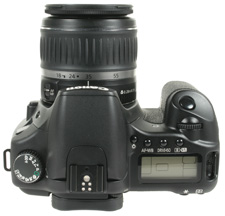 |
To the right side, three buttons above the backlit LCD status screen adjust a pair of settings each, with either a turn of the rear command wheel, or the finger wheel by the soft-touch shutter release.
The left button adjusts the three autofocus modes (One Shot, AI Focus and AI Servo) and the nine white balance options (including both custom and user-selectable temperatures between 2,800 and 10,000K).
The middle button adjusts the four drive modes (single, continuous, continuous high and self-timer) or the ISO sensitivity in third-stop increments. Standard ISO settings range from 100 to 1600, although a custom function – see later – extends the upper end to 3200 ISO, although unlike the 5D, there’s no 50 ISO equivalent. Finally, the right button selects between the four metering modes of centre-weighted, spot, partial and evaluative, along with adjusting flash compensation between +/-2EV in third-stop increments. Spot metering wasn’t featured on the 20D, and like the bigger screen, it’s a much-needed and welcome improvement.
The same scale on the upper LCD screen is used for both flash and exposure compensation adjustments, with the latter taking priority during normal operation. A small icon then reveals if any flash compensation has been set, but you’ll need to press the right button to actually check the value. Similarly you’ll need to press the middle button to reveal the ISO sensitivity. Other than the ISO and flash compensation values though, all other main settings described here, along with shutter, aperture, picture quality, battery life and remaining shots are shown at all times.
Nestled in the top right corner on the back of the camera just behind the status screen are the exposure lock and focus point buttons. The latter offers manual selection of the nine focus points, using a guide temporarily shown on either the LCD status screen or superimposed through the viewfinder. Both buttons double-up as zoom controls during playback.
Canon EOS 30D connectivity and battery
All the ports are hidden behind a single large rubber flap, although it’s designed in two sections which can be unfurled independently. Behind the upper section are the mini USB 2.0 and video out ports, while behind the lower section are the PC Sync flash port and a plug for an N3-type remote control.
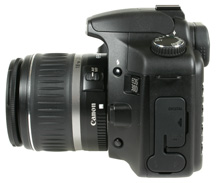 |
Behind the right flap are a USB-2 port and video output. Wireless connectivity is possible with the optional WFT-E1 module which screws to the base of the body. Like the 5D, there’s no option for audio recording, and unlike the Nikon D200, no GPS connectivity either.
The 30D’s powered by a single BP-511A Lithium Ion battery pack and is supplied with a mains recharger. The pack’s rated at 1390mAh and Canon claims to have extended its effective life over the 20D, quoting 750 shots per charge at 20 degrees Celsius under CIPA testing conditions. Like other Canon DSLRs, the battery life is indicated by a two segment icon alone which begins to flash when you’re close to expiring. As we mentioned in our 5D review, it’s a shame Canon hasn’t followed Nikon and Sony’s leads in providing finer indication of battery life.
That said the BP-511A is an excellent pack which delivers an impressive lifespan. If you’re after longer still, the 30D can handle the same BG-E2 battery grip as the 20D, offering a portrait grip and room for two BP-511As, or six AAs if you’re really desperate.




